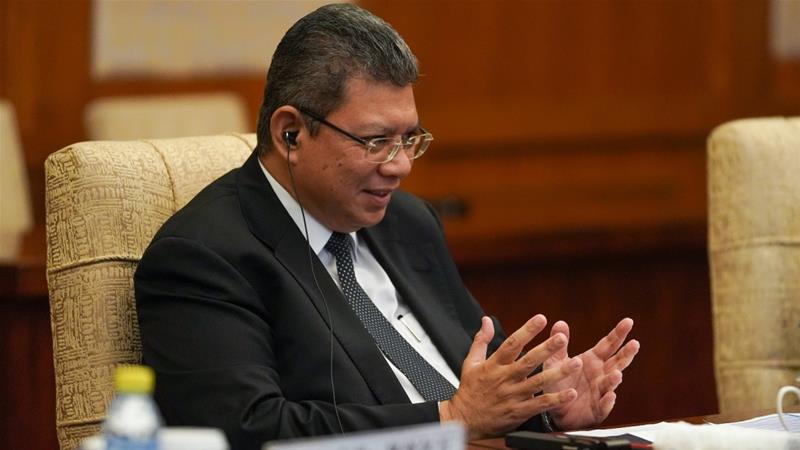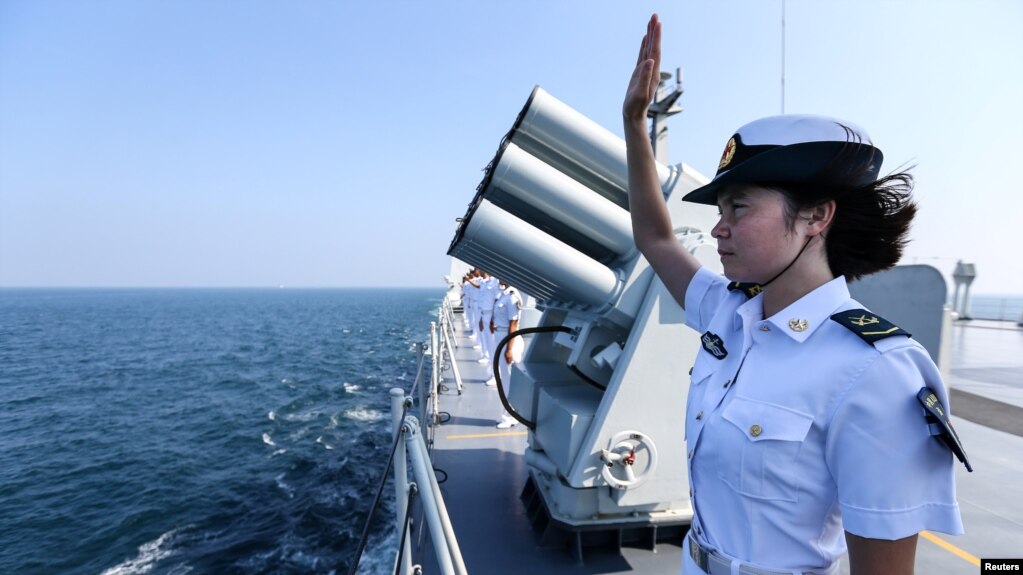Deterring aggression in the “gray zone” is hard.
The keeper of an existing order—an order such as freedom of the sea—finds itself conflicted.
That’s because gray-zone aggressors deliberately refuse to breach the threshold between uneasy peace and armed conflict, justifying a martial response.
They can act first and bear the blame for the outbreak of war, for taking excessive risk, for provoking the revisionist power or for destabilizing the peace.
Or, unwilling to incur such costs, they resign themselves to inaction or half-measures.
Predisposed to put off difficult decisions, politicians can waffle, and surrender the initiative.
Or they can escalate, and see their nation branded a bully.
An unpalatable choice.
Gray-zone strategies are designed precisely to impose such quandaries on custodians of an existing order.
The stepwise approach is reminiscent of
the late Thomas Schelling’s parable of the rebellious child who whittles down his parents’ willpower at the seashore.
“Tell a child not to go in the water,” maintains Schelling, “and he’ll sit on the bank and submerge his bare feet; he is not yet ‘in’ the water. Acquiesce, and he’ll stand up; no more of him is in the water than before. Think it over, and he’ll start wading, not going any deeper; take a moment to decide whether this is different and he’ll go a little deeper, arguing that since he goes back and forth it all averages out. Pretty soon we are calling to him not to swim out of sight, wondering whatever happened to all our discipline.”
Over the past couple of decades, likewise,
Beijing has devised a variety of stratagems to flummox those who defy its claims to sovereignty over islands, sea and sky.
China started out with light-gray, largely inoffensive gray-zone tactics twenty-five years ago, but they darkened into coercion over time as its ambitions and power mounted.
First, the Chinese Communist Party (CCP) leadership codified its claim to offshore territory in
domestic law in 1992, proclaiming that China held jurisdiction over disputed land features in the East and South China seas along with the surrounding waters.
Western governments and press outlets deemed this development barely newsworthy, in large measure because Beijing made little effort to enforce the law.
Though light in tincture, however, this Law on the Territorial Sea and Contiguous Zone comprised an extravagant statement of purpose toward China’s near seas.
This largely forgotten edict prepared the way for additional assertions of legal authority while justifying more muscular gray-zone strategies.
In 2009, for instance, the CCP leadership delivered
a map of the South China Sea to the United Nations bearing a
“nine-dash line” that delineated its claim to
“indisputable” or “irrefutable” sovereignty over some 80–90 percent of that waterway.
It later flouted a 2016 ruling from the Permanent Court of Arbitration that gutted its legal case for sovereignty.
Beijing has little fealty to commitments it has freely undertaken—commitments such as the UN Convention on the Law of the Sea—when operating in the gray zone.
China also projected its claims skyward.
In 2013 the leadership declared an air-defense identification zone over the East China Sea, encompassing Japanese- and Korean-administered islands.
It asserted the power to regulate air traffic moving up and down the Asian seaboard, parallel to the coast, rather than traffic bound for China.
Controlling airspace—not defending China against inbound aircraft—represented its true aim.
Yet here, too, Beijing has only halfheartedly sought to enforce its air-defense zone—most recently by
challenging a U.S. Air Force bomber bound for South Korea.
Its skyward strategy remains light gray in execution, if not in principle.
Second, China’s “smile diplomacy” ranked as the lightest of light-gray ventures.
Commencing in the early 2000s, Beijing fashioned a diplomatic narrative drawing on the charisma of China’s ancient mariner,
Zheng He.
The Ming Dynasty admiral commanded a series of “treasure voyages” six centuries ago, reinvigorating China’s tribute system in Southeast and South Asia without indulging in territorial conquest.
Modern-day officialdom took pains to reassure fellow Asians that China would follow Zheng He’s pattern.
It would make itself a potent yet beneficent sea power.
It could be trusted not to abuse lesser neighbors.
In short, smile diplomacy constituted an effort to
brand China as a uniquely trustworthy great power—and mute resistance to its maritime rise.
Until the late 2000s, when China turned more assertive, regional audiences were by and large receptive to this soothing message.
Third,
gray-zone tactics tended in a darker, more coercive direction after Beijing unveiled the nine-dash line in 2009.
Zheng He found himself summarily jettisoned in favor of what we dubbed “
small-stick diplomacy.”
Rather than flourish the big stick of naval power, that is, CCP leaders unlimbered the small stick of maritime law enforcement coupled with militiamen embedded within the fishing fleet.
Small-stick diplomacy represented a masterful gray-zone strategy.
The small stick was big enough to cow Asian neighbors whose navies barely rated as coast guards, but it was too small to goad the United States into sending its navy to defend allies and friends.
Routine harassment of Asian coastal states projected the image that China’s coast guard and maritime enforcement services were simply policing waters that had belonged to China since "remote antiquity". It was an effort to quash lawbreakers trespassing on Chinese territory.
Small-stick diplomacy, in short, comprised a gray-zone strategy vis-à-vis the U.S. Navy but exhibited a dark, coercive hue toward Asian claimants.
And that dualism suited Beijing just fine.
Fourth,
China attempted a variant of small-stick diplomacy in the East China Sea but found the setting far less permissive.
Since 2010 or thereabouts, China’s coast guard has conducted regular patrols in the waters around the
Senkaku Islands.
Its purpose: to challenge Japan’s administrative control of the islands and adjoining seas.
For its part,
Tokyo has staged a standing coast-guard presence in the archipelago’s territorial sea, buttressing its own control.
The result is a curious form of joint Sino-Japanese administration of waters around the islets.
Both sides police what they regard as their own.
While the Obama administration and Trump administration have reaffirmed that the U.S.-Japan Security Treaty applies to the Senkaku Islands, obliging Washington, DC to help defend them against attack, China’s East China Sea strategy displays the same kind of dualism as in the South China Sea.
It’s coercive toward Japan yet stops short of triggering U.S. countermeasures.
This tactic was enough to alter the status quo in China’s favor but not enough to trigger escalatory action-reaction cycles with Japan.
And
it keeps in play Tokyo’s insecurities about America’s commitment to Japan’s defense, granting China leverage over the alliance.
In all likelihood this state of affairs will persist so long as Beijing refrains from trying to wrest the islets from Japan—so long, that is, as China keeps its strategy gray.
And fifth,
CCP chieftains have discovered that building artificial islands—or fortifying existing ones—constitutes an effective gray-zone strategy.
Its island-building enterprise has taken several forms over the years.
In 1994, for example, China occupied Mischief Reef, deep within the Philippine exclusive economic zone.
It commenced constructing structures at the reef soon afterward, converted it into a military outpost in 1998, and expanded it sufficiently to host an airstrip and defensive armaments by 2016.
If gradualism suited its purposes at Mischief Reef, China has exercised even more forbearance at Scarborough Shoal, another feature within the Philippines’ exclusive economic zone.
Its occupation of Scarborough Shoal in 2012 marked the final transition from smile diplomacy to small-stick diplomacy.
China’s seagoing law-enforcement services shooed away Philippine mariners from this traditional fishing ground, imposing control over access to the shoal.
Engineers, however, have yet to begin reclaiming seafloor around it to erect another armed redoubt.
Why such restraint?
Geography may have dissuaded Beijing from acting.
Unlike the other contested features, Scarborough Shoal perches near the principal Philippine island of Luzon.
China’s leadership may fear drawing in the U.S. military, which is obligated to defend the Philippines under a longstanding mutual-defense pact, if it constructs a fortified outpost so close to an American ally.
Politics is at work as well.
Elected in 2016, furthermore, Rodrigo Duterte has signaled his willingness to loosen the alliance with America while cozying up to China.
That being the case, refraining from provocative acts probably appears prudent to CCP leaders.
Why alienate a new ally?
And lastly, China went big, and fast, elsewhere in the Spratly and Paracel archipelagoes.
Starting in 2013, civil engineers manufactured island bases from
rocks and atolls scattered across the South China Sea.
Xi Jinping pledged not to “militarize” the artificial islands, freezing any serious response from the Obama administration, only to proceed with construction of airfields and other infrastructure.
The result: a fait accompli.
It’s one thing to deter an aggressor from seizing ground, quite another to evict an aggressor from ground it has already seized.
Island-building tactics of all three varieties have left China in possession of territory—and it’s hard to see how such gains can be reversed short of open warfare.
Beijing has, in essence, forced the region and the United States to live with a new and largely irreversible strategic reality.
This typology of gray-zone tactics suggests that China is bringing to bear all elements of national power on the maritime disputes in the East and South China Seas.
Beijing has employed legal, diplomatic, maritime and material elements of statecraft to chip away at the U.S.-led liberal international order.
Even its construction prowess, honed over decades of massive infrastructure-building, has been on dazzling display in the heart of the South China Sea—contributing to strategic success.
For custodians of the current order, consequently, it is not enough to think exclusively about the marine dimensions of strategy.
To balk China’s gray-zone stratagems, Washington and its allies must take a page from Beijing and adopt a holistic, grand-strategic posture that applies patient, vigilant countervailing pressure on many fronts simultaneously.
In short, the defenders of the status quo must think in shades of gray and must accustom themselves to acting in the twilight between peace and war.
To do any less would concede to China the initiative—and the future shape of the regional order.
Thomas Schelling would nod knowingly at the challenges before Washington and its partners.
Unlike his milquetoast parents, let’s muster some strategic discipline.


 Natuna Islands
Natuna Islands  Malaysian Foreign Minister Saifuddin Abdullah said he expects ASEAN to further debate in the coming months the need for a 'Code of Conduct' with China over the South China Sea issue
Malaysian Foreign Minister Saifuddin Abdullah said he expects ASEAN to further debate in the coming months the need for a 'Code of Conduct' with China over the South China Sea issue 

